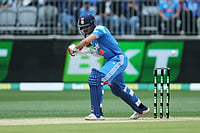The steps descend to a walkway that eventually leads to an open expanse of paddy fields. The 200-metre stretch of red soil is bordered with a strong line of fence that has been painted white for the occasion. The houses on both sides are mostly vintage, adding to the ambience of the centuries-old temple festival. Peruvanam village is all decked up for its most famous pooram celebration.
There is one thing special about the backstreet of the imposing Hindu shrine by Cherpu, eight km south of Thrissur, which is called the cultural capital of Kerala. It has the space to accommodate no less than seven elephants—and no more of it. The raised walls on both sides give added acoustic effect to the location; so much so one feels there’s an unseen loudspeaker. That’s quite unlike the general sound system with one of the equally famous poorams in the locality—more on that later. The common factor, though, is the row of tuskers. They symbolise the pompousness of the evening-to-dawn revelry, giving the visual splendour to percussion ensembles that are most grandly presented in central Kerala of all places in slender southern Indian state.

This year’s Peruvanam pooram just got over, typifying an unlikely blend of flamboyance and piety that is characteristic of such rustic fares around the semi-hilly area that is immensely green even in the summer months. Right ahead of the dusk on Wednesday (April 4 was the date this time as per the lunar Malayalam calendar’s meenam month), four major melams—as is the name of the traditional orchestra led by rows of vertical chenda drums—unveiled in succession amid a humid air that somewhat cooled down as day broke in the horizon opposite a line-up of caparisoned jumbos with white parasols atop them. Apart from the melams, Peruvanam pooram hosts a couple of harmonic concerts called the panchavadyam, which ideally features close to 60 artistes playing five ethnic instruments: the longish timila (the anchor), the weight maddalam and ilathalam cymbals besides the horns (kombu) and the hourglass-shaped handy drum called edakka slotted on both end of the rows where the timila and maddalam stand face-to-face.
The centerpiece of Peruvanam pooram—which has an antiquity of 1,400 years—is, indisputably, a melam that spans close to four hours and occupies the post-midnight slot. Simply called Urakam panchari. The first word is the name of the temple deity that would be mounted on to the middle elephant as the procession goes up the path amid rows of country torches lit up in a stylised fashion. The second term denotes the name of the rhythm: a six-beat cycle that corresponds to roopakam in the Carnatic system of Dravidian music or ek taal in Hindustani further north.
Incidentally, panchari melam progresses in a pattern that has parallels with the classical music upcountry. If the khayal stream of Hindustani begins in an extremely slow tempo (vilambit lay) that builds momentum to the middle (maddhya lay) and then becomes reasonably fast (dhrut) at the end, panchari gains heights in a similar way—over five chapters (called kaalam). The lowest tier is built in a way where the six-beat taalam is expanded to a cycle of 96 beats—and made to sound ornate without permitting exhibition of individual talent. It is a team work by 150-odd artistes playing the weighty chenda (15), its bass version (50), the cymbals (50), horn (kombu totalling 15 to 17) and as many kurumkuzhal—the foot-long pipe that plays the anchor. Sessions of minor fireworks punctuate the night, least disturbing the rhythms.
The start of the pooram festivities gives way to a grand face-to-face where a panchari melam procession by Chathakudam Shasta temple comes opposite another elephant-row orchestra called paandi up the temple street. Paandi, basically of seven beats, is a 150-minute concert that is innately more vigorous than panchari. The fag-end melam, jointly by local temple deities Cherpu and Ayyankunnu (a sight this morning), has midway its profile the sun rising in the east and the early golden rays illuminating the spot.

Quite in contrast to the compactness of the location of this festivity is another such annual festival that is held in open fields not far from Peruvanam. At the sprawling post-harvest Poochinni grounds adjoining the famed but not-so-big Ayyappa temple is the Arattupuzha pooram that ends up with a joint procession featuring 80-plus elephants in one incredible row—again, amid the sunrise. In the expansive venue, there is less conservation of sound, yet the loudness isn’t lost, courtesy the thick human wall around the ensembles. Even so, the natural amplifier (vis-à-vis Peruvanam) is largely absent.
Arattupuzha, too, has a variety of melams and a few panchavadyam symphonies, but what stands out is a post-dusk panchari of the hosting Shasta shrine. With 15 elephants in a row and people spread across a kilometre radius, that four-hour melam has a popularity like none other—more so a with a detailed fifth chapter that takes one-fourth the time of the whole concert. Spectators, especially youngsters, go into a frenzy that is only increasing over the recent years, somewhat to the discomfiture of an older generation of melam buffs. Almost a dozen melams—successive and sometimes overlapping—across the space make the pooram a heady fare.

The arrival of the Rama deity along the main dyke of the fields from the not-so-far Thriprayar temple continues to be a solemn sight, lending an added anticipatory value to Arattupuzha pooram that falls this weekend (April 8).
This time the melams bear historicity around one artiste, as celebrated lead drummer Peruvanam Kuttan Marar completes his 50th year in the ensemble circuit.
(The videos are from earlier editions of the festivals.)


























